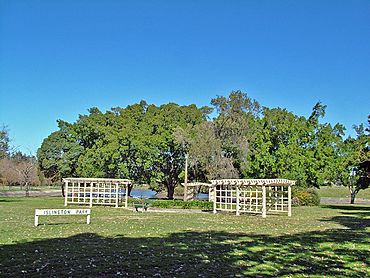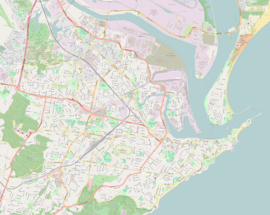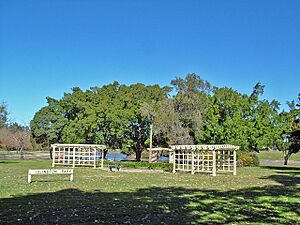Islington, New South Wales facts for kids
Quick facts for kids IslingtonNewcastle, New South Wales |
|||||||||||||||
|---|---|---|---|---|---|---|---|---|---|---|---|---|---|---|---|

Islington Park, looking towards Throsby Creek
|
|||||||||||||||
| Population | 1,883 (2016 census) | ||||||||||||||
| • Density | 2,145/km2 (5,560/sq mi) | ||||||||||||||
| Established | 1870s | ||||||||||||||
| Postcode(s) | 2296 | ||||||||||||||
| Area | 0.713 km2 (0.3 sq mi) | ||||||||||||||
| Location | |||||||||||||||
| LGA(s) | City of Newcastle | ||||||||||||||
| Region | Hunter | ||||||||||||||
| County | Northumberland | ||||||||||||||
| Parish | Newcastle | ||||||||||||||
| State electorate(s) | Newcastle | ||||||||||||||
| Federal Division(s) | Newcastle | ||||||||||||||
|
|||||||||||||||
|
|||||||||||||||
Islington is a suburb of Newcastle in the Hunter Region of New South Wales, Australia. It is only about 3.4 kilometers (2.1 miles) from Newcastle's main city area. Islington first grew as a place for people to live. Today, it has a small industrial area and is next to a campus of the Hunter Institute of Technology. A major railway line runs along its southeastern edge. The suburb shares a train station, called Hamilton, with the nearby suburb of Hamilton.
Contents
History of Islington
Islington began to develop in the 1870s as a residential area. It is located along Maitland Road, which was once a very important highway. Its easy-to-reach location attracted small factories to the area.
The Regent Theatre
The Regent Theatre in Islington opened on December 2, 1928. It was located at the corner of Maitland Road and Beaumont Street. By the early 1940s, a company called Hoyts Theatres owned most of the property. However, when television became popular, the Regent Theatre could not stay open. It closed on June 27, 1964. After being empty for five years, the building reopened in August 1969 as a hardware store. It still operates as a hardware store today.
Italian Settlers
In 1947, a group of nearly 150 families from a village in Italy called Lettopalena settled in the Islington area. They chose Islington mainly because it was close to the BHP steel works. This meant there were jobs available for them nearby.
Islington Today
Islington is a lively suburb with several interesting features.
Islington Park and Recreation
Islington Park is a nice green space located along Throsby Creek. It has a special path for bikes that connects Islington to the redeveloped waterfront area of Newcastle. This makes it easy for people to cycle and enjoy the outdoors.
Shopping and Dining
Islington is located at the northeastern end of Beaumont Street, which is famous in Newcastle for its many restaurants. Islington is also known as Newcastle's "antique district." You can find many antique shops, mostly along Maitland Road, which is also where Islington's main shopping area is located. More shops can be found on Beaumont Street.
Getting Around Islington
Islington has good transport links, making it easy to travel to and from the suburb.
Roads and Buses
Maitland Road is a main road that runs through Islington. It connects the suburb to other areas like Mayfield and Newcastle West. Many bus services operate along Maitland Road, including routes 11, 138, 140, and 55N. These buses are run by Newcastle Transport.
Train Services
The Hamilton railway station is located on the southern edge of Islington. This station is part of the Main Northern railway line. From Hamilton station, you can catch regular train services to places like Maitland, Newcastle Interchange, and even Sydney.
Islington's Population
In 2016, there were 1,883 people living in Islington. The average age of residents was 34 years old. Most people, about 81.6%, were born in Australia. Other countries of birth included England (1.8%), New Zealand (1.2%), India (0.9%), Afghanistan (0.8%), and the Philippines (0.7%).
When it came to religion, 50% of people said they had no religion. About 15.8% were Catholic, 10.4% were Anglican, and 2.7% identified as Christian. English was the only language spoken at home by 85.4% of residents. Other languages spoken at home included Italian (0.9%), Hazaraghi (0.7%), Japanese (0.6%), German (0.5%), and Dinka (0.5%).



